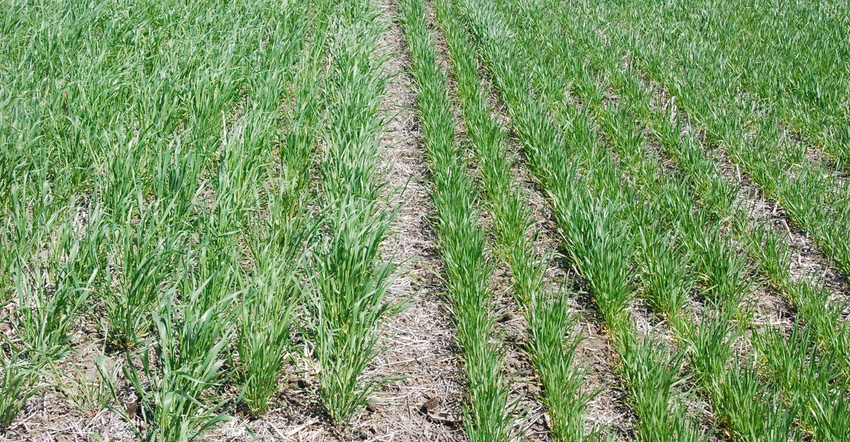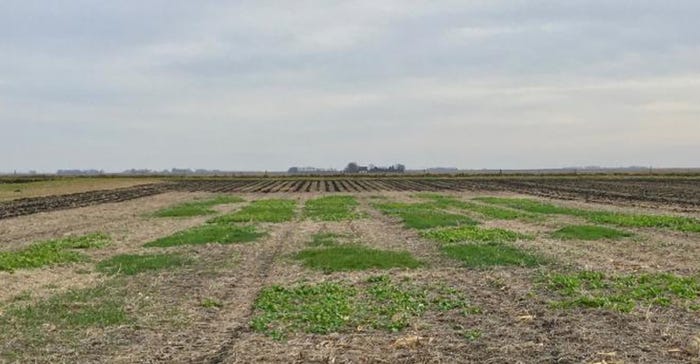December 5, 2017

By Chelsea Harbach
The number of acres planted to cover crops annually has been steadily increasing in recent years throughout the U.S. Meanwhile, soybean cyst nematode continues to top the U.S. list of yield-suppressing pathogens. It’s no coincidence, then, that interest is increasing regarding the potential for these two factors to interact in the field, particularly with the possibility that cover crops could decrease SCN populations.
When considering the potential effects of cover crops on SCN, there are several possibilities.
First, it is possible that cover crops could serve as hosts for SCN reproduction, thereby inadvertently increasing SCN population densities in fields where these plants are grown. Many cover crop species have been found to be non-hosts for SCN; however, we cannot say that all cover crops are non-hosts as some species can support SCN reproduction, including crimson clover, field pennycress and more.
Second, it is possible that there is no effect of cover crops on SCN population densities. Last, and most interesting, there is the potential that cover crops may decrease SCN population densities.
Cover crops could decrease SCN population densities, however, in these ways:
• Producing nematicidal compounds. Some plants, notably members of the Brassicaceae family (which includes radish, mustard and canola), produce methyl-isothiocyanates as they decompose. These compounds have nematicidal properties.
• Serving as a trap crop. If SCN juveniles hatch and enter roots of cover crops, it is unlikely they will be able to serve as a host. Being unable to establish a feeding cell, the juveniles would subsequently be “trapped” and die in the plant roots. Ideally, to serve as an effective trap crop, many nematodes would enter the roots to decrease SCN numbers.
• Inducing hatching of juveniles from eggs. As plants grow, the roots in the soil give off compounds called root exudates. It is possible that cover crop root exudates could stimulate hatch of SCN juveniles in the fall or spring. If the juveniles hatch at these times, there is likely no food source for them so they would die of starvation in the soil.
• Producing inhibitory allelochemicals. Some plant roots may produce inhibitory allelochemicals, either while living or decomposing, that affect other organisms. Such allelochemicals may inhibit the hatch of SCN juveniles, which would make the pathogen less productive overall.

SCN TEST PLOTS: Cover crops grow in late fall in an SCN-soybean research experiment plot at the ISU Northern Research and Demonstration Farm in Kanawha, Iowa.

Can some kinds of cover crops reduce SCN population?
There have been few published scientific studies of how different cover crop species may have a negative effect on SCN numbers. Additionally, there are no data on whether different cultivars within a species of cover crop have differential impacts on SCN numbers.
Some companies describe cover crops as providing benefits such as “reducing SCN population densities” or more generally as “decreasing nematode populations” but there are no data to substantiate the claims. There are a few scientific reports that suggest some cover crop species can reduce SCN population densities. These reports lack necessary details of the studies, were not reproduced over a sufficient range of locations and growing seasons, or contain results that are inconsistent among locations and years.
ISU working with Iowa Soybean Association
The situation I’ve described here leads to the premise of the cover crop and SCN experiments I am working on in Greg Tylka's lab at Iowa State University. This research is funded in part by NCR-SARE's Graduate Student Grant Program. While we have an inkling of an idea about how cover crops could affect SCN population densities, my work is taking a deep dive into this interaction to provide a well-thought-out and comprehensive look at this interaction.
The experiments I am conducting range from large-scale, on-farm strip trials coordinated though a collaborative effort with the Iowa Soybean Association, to laboratory assessments of how root exudates from specific cover crops may affect the hatch of SCN juveniles.
The potential benefit of cover crops in decreasing SCN population densities and the scarcity of robust data describing the situation are why I am working to determine the effects of cover crops on SCN at Iowa State University. Researchers at other universities in the north-central region are working on this puzzle as well, including those at Michigan State University, University of Missouri, North Dakota State University, Ohio State University, and perhaps even other institutions. With these combined efforts, there should be a much clearer understanding of the potential benefits and limitations of cover crops for managing SCN in the upcoming years.
Harbach is a graduate student at Iowa State University.
You May Also Like




